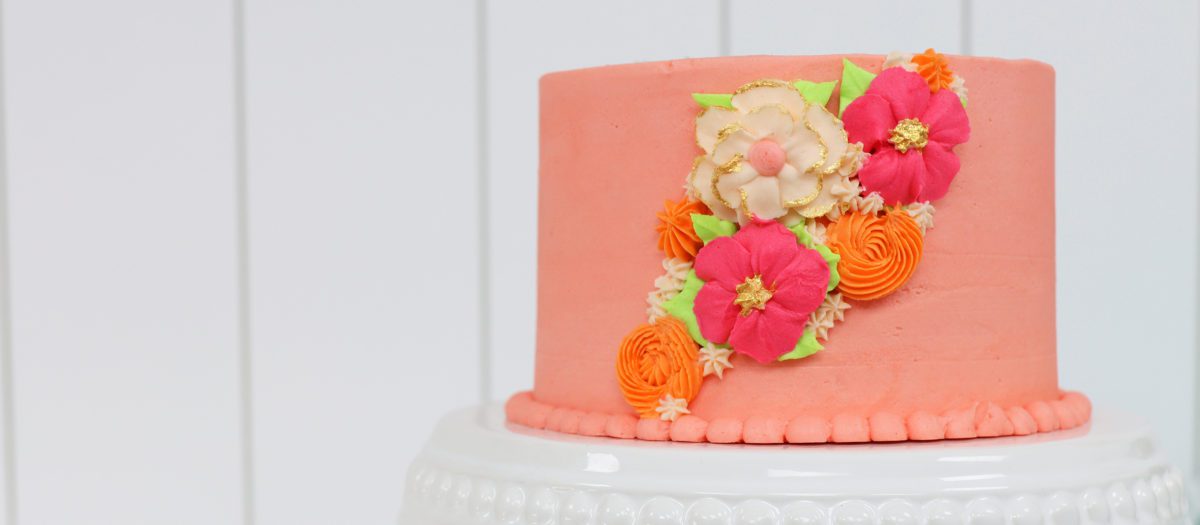
A delicious cake with pretty frosting will make people happy but with these 10 techniques I’ll show you how to impress EVERYONE with your cakes, from piping details to transferring a cake onto a cake stand, using simple tricks, basic tools, and quick techniques!
If you prefer to watch a video of this tutorial, scroll to the bottom of the page.
#1 Swirls
For this first technique all you need is a piping bag and a star shaped piping tip like a 1M or a 2D. Fill your piping bag about half full with whatever frosting you’re using. I like to do this within a glass to make it neater, so you don’t get frosting all over the top of the piping bag.
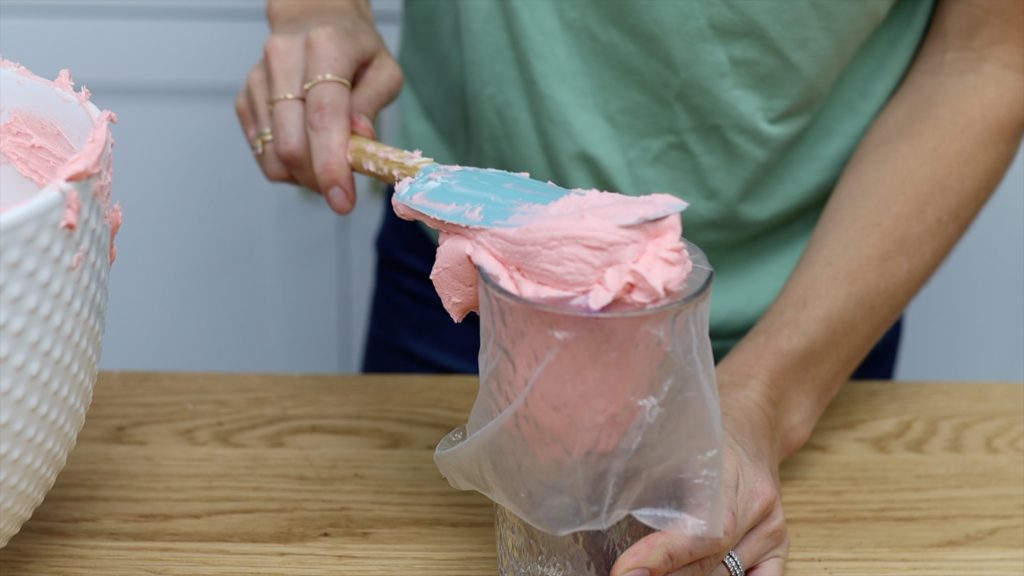
Twist the end of the bag to make it easier to pipe because you won’t need as much pressure to squeeze the frosting out. I like to chill my cakes before piping onto them, and I’ll show you why in a second.
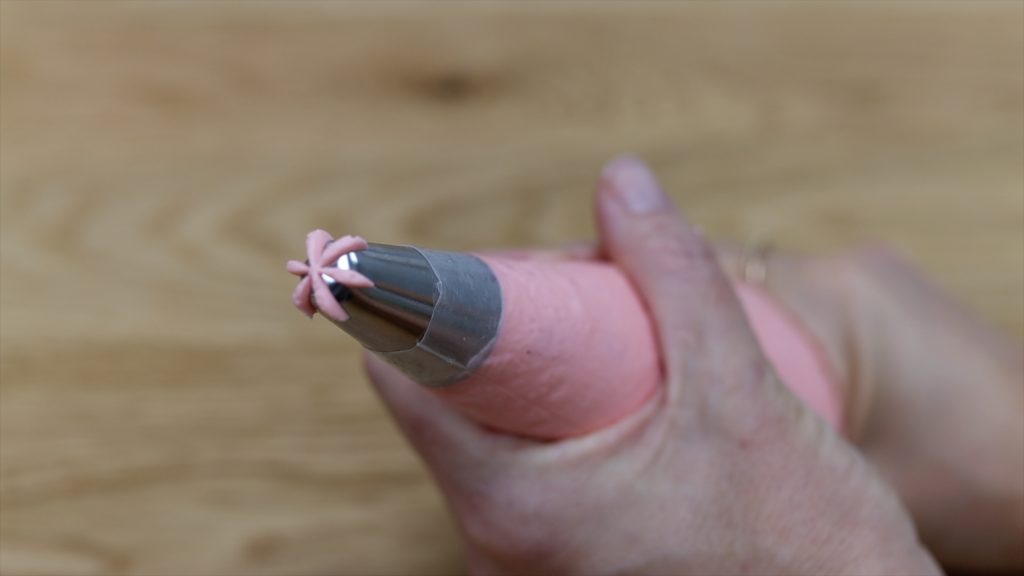
Hold the piping bag above the cake, starting about an inch in from the edge, and pipe a circle, spiralling upwards to pipe a swirl. If you count the number of circles you make for the swirl, you can replicate that around the cake and every swirl will be the same height. At the top of each swirl I like to push down slightly, then stop squeezing the bag and swipe the piping tip up and away, and that leaves a nice neat peak on each swirl.
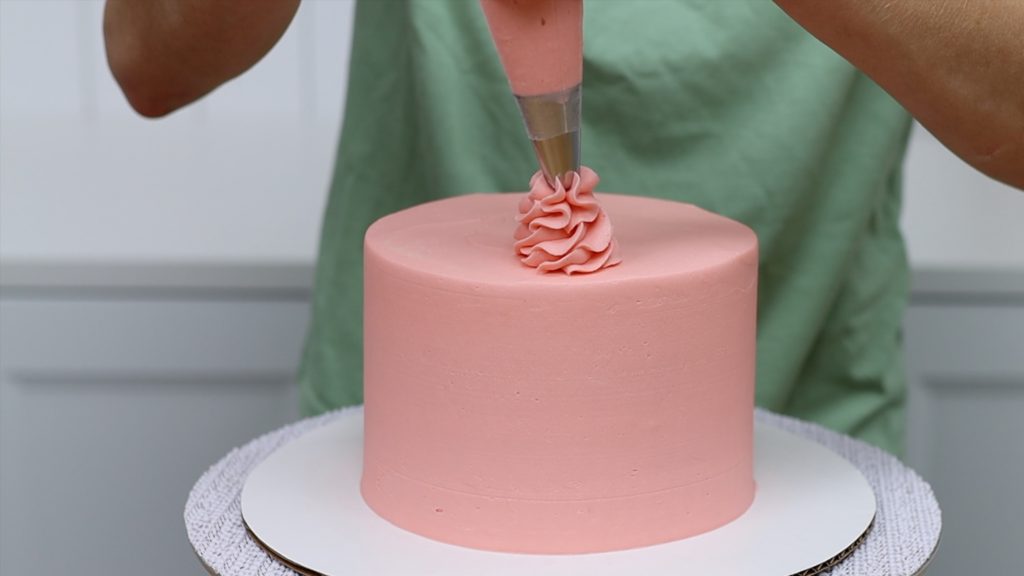
The reason for chilling the cake before you do this is that these frosting swirls are quite heavy and if you pipe onto a cake just after frosting it, the weight of the swirls can make the top edge of the frosting on the cake droop. If you chill the cake the frosting will set and you’ll keep those nice sharp edges around the top of the cake even after piping all of the swirls. These swirls are SO easy to pipe and they make the cake much taller, more elegant, and more festive!
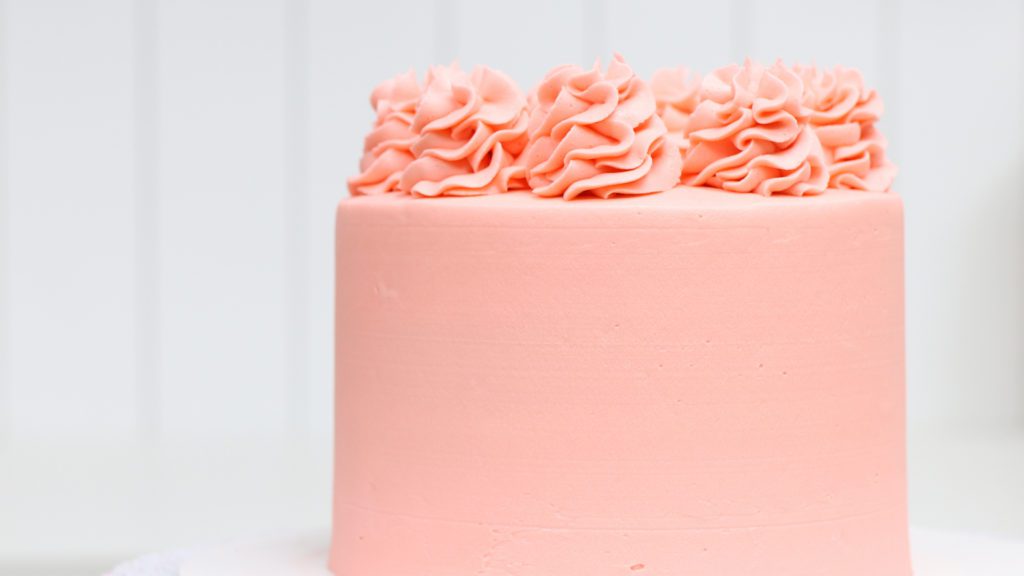
#2 Rope border
For a more unique way to add some detail to the top of your cake, use the same star tip and hold the piping bag at a diagonal and pipe a circle. Just before the end of the circle, loop back around to make another circle that overlaps the first one.
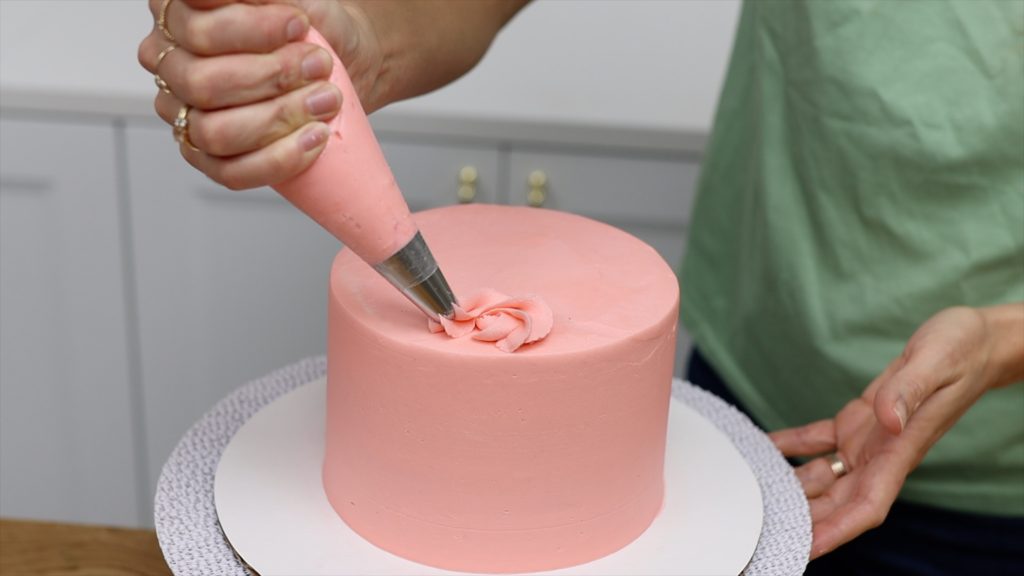
Continue like this to make a border that looks like the links of a rope. Using a 2D tip makes the piped ruffles much softer than using a 1M tip, which will make the texture sharper.
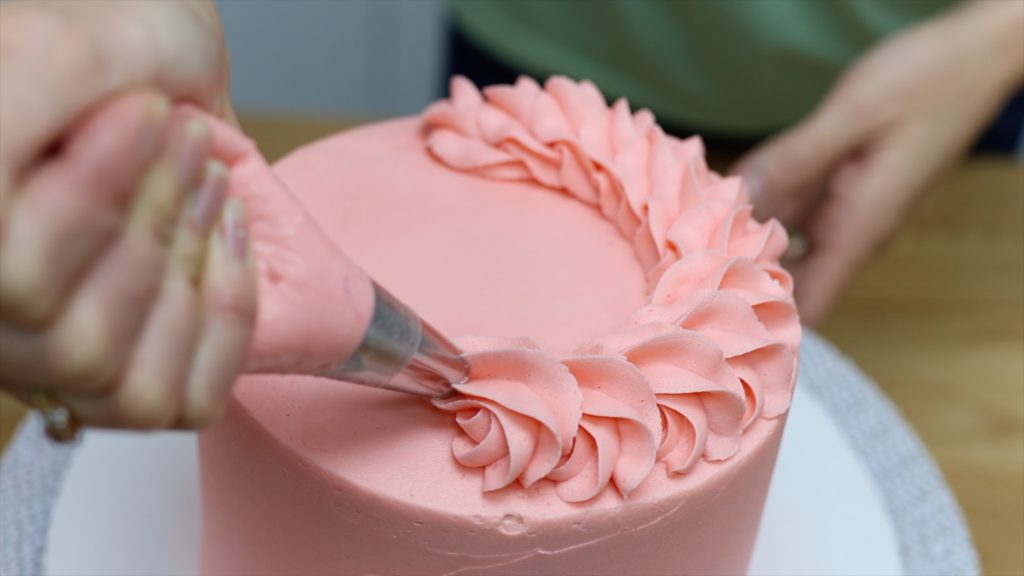
A rope border isn’t as tall as frosting swirls, which makes it perfect to use with a cake topper because it won’t block or hide the cake topper.
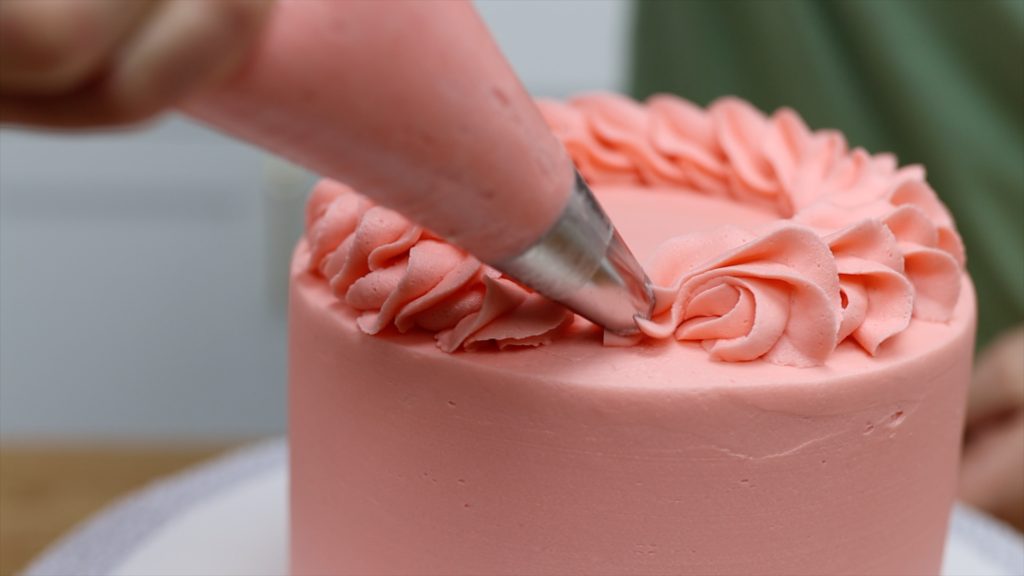
#3 Stencil
Next up, stencils! These are much easier to use than you might think. Tint another colour of frosting and spoiler alert: buttercream works best for this and you’ll see why in a second. Choose a stencil – plastic, acrylic, any material is fine. What’s essential for successful stenciling is that the cake has been chilled so the frosting is really firm, and that way you can press the stencil against the cake without damaging the frosting.

Spread buttercream to cover the whole stencil design and then scrape off the excess to leave a thin, smooth layer over the stencil. Peel the stencil off and voila!
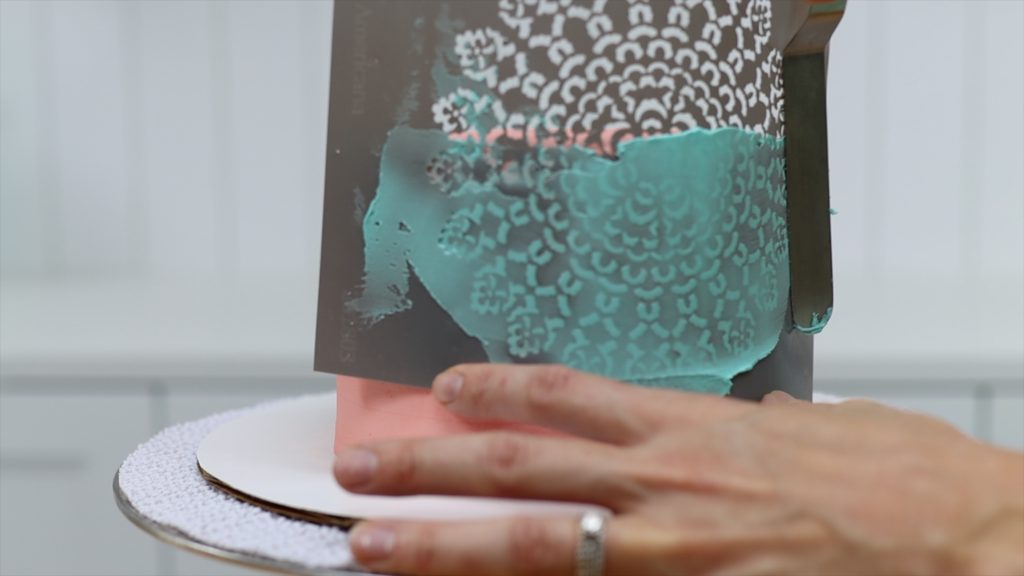
If the warmth of your fingers leaves indents in the frosting you can smooth those with your offset spatula now, and after chilling the cake again you can smooth them even more.
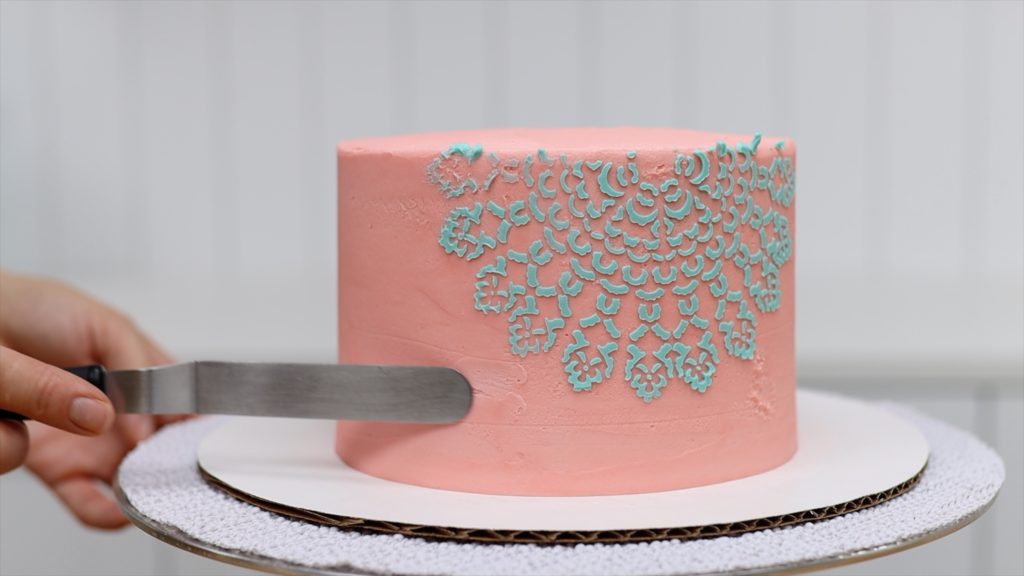
Stencils are even easier on the top of cakes because they lie flat – you don’t have to curve them around the cake. Follow the same process of spreading buttercream and then scraping it off and smoothing it, and then peel the stencil off.
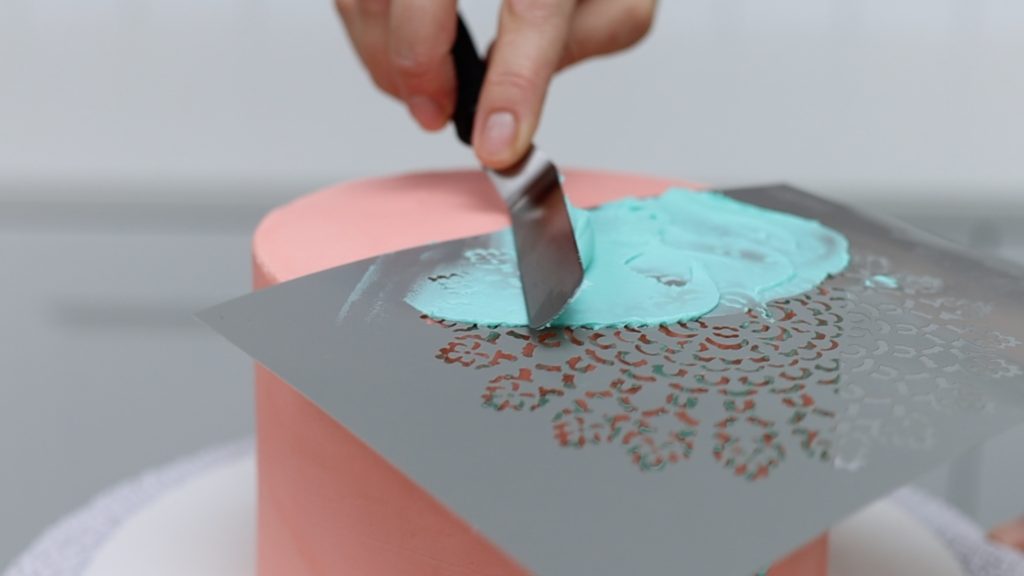
You can tidy up any excess bits of frosting with a toothpick to make the design neater. Stencilled cakes are quick and easy but SO beautiful!
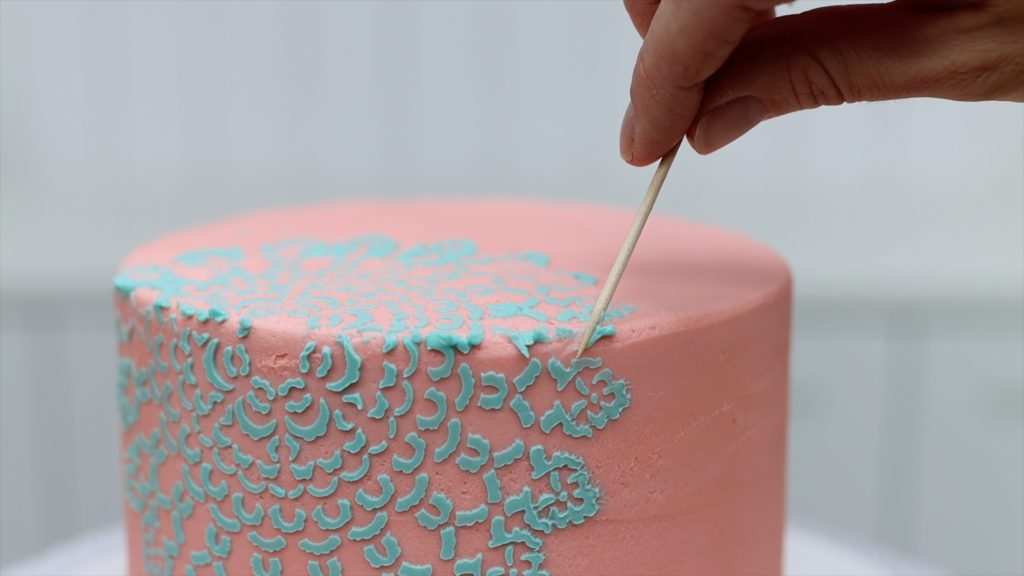
#4 Beaded border
Borders around the bottom of the cake are a nice way to soften the base of the cake, and also to disguise any imperfections around the bottom of the cake! Choose a medium sized round tip, like this #12, for the neatest beads.
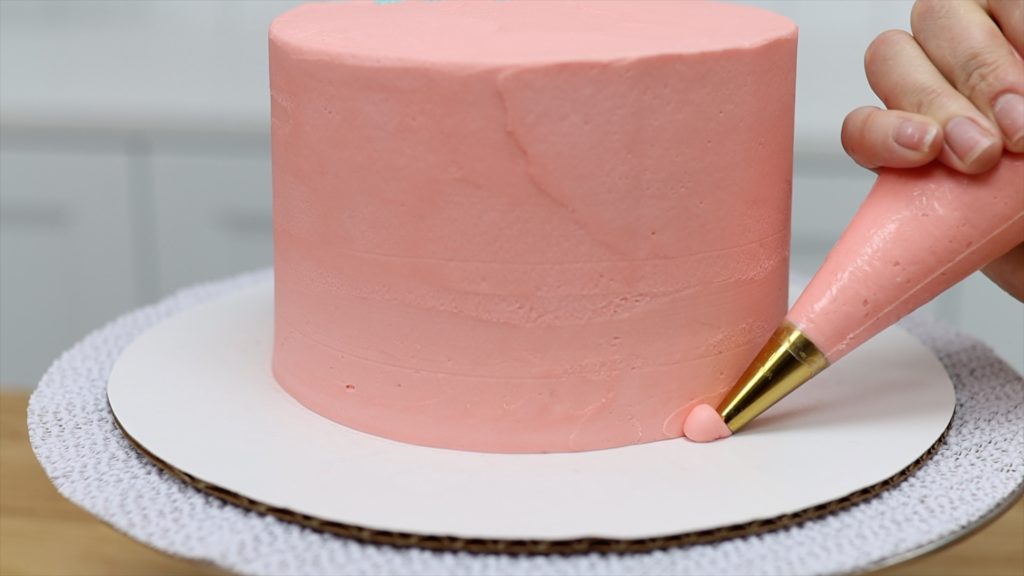
Hold it up against the side of the cake and squeeze the bag to push the frosting out, letting it bulge out slightly before pulling away. This leaves a tail on each bead, which you’ll cover up with the next bead.
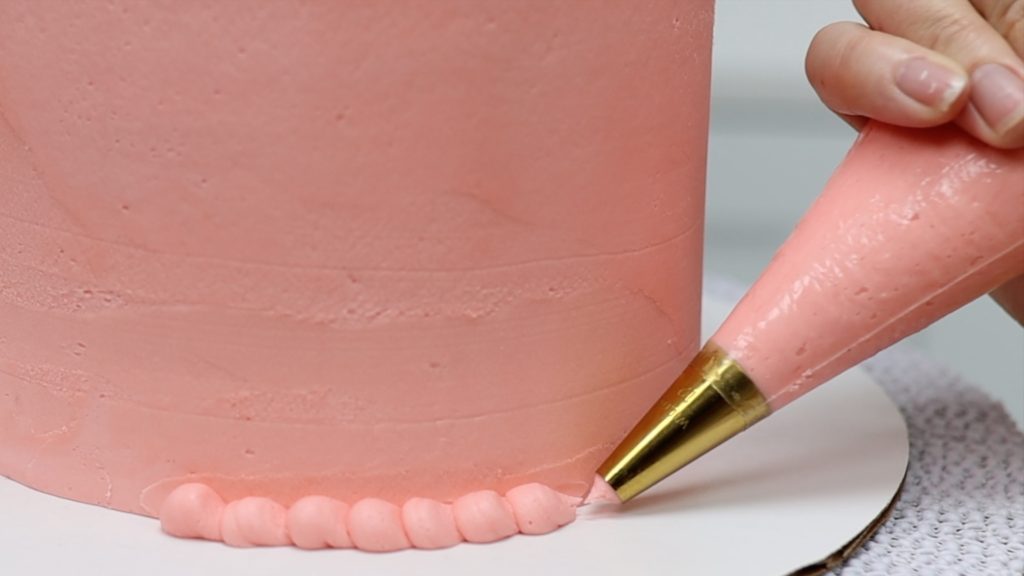
This finishing touch makes a pretty cake look professional instantly!
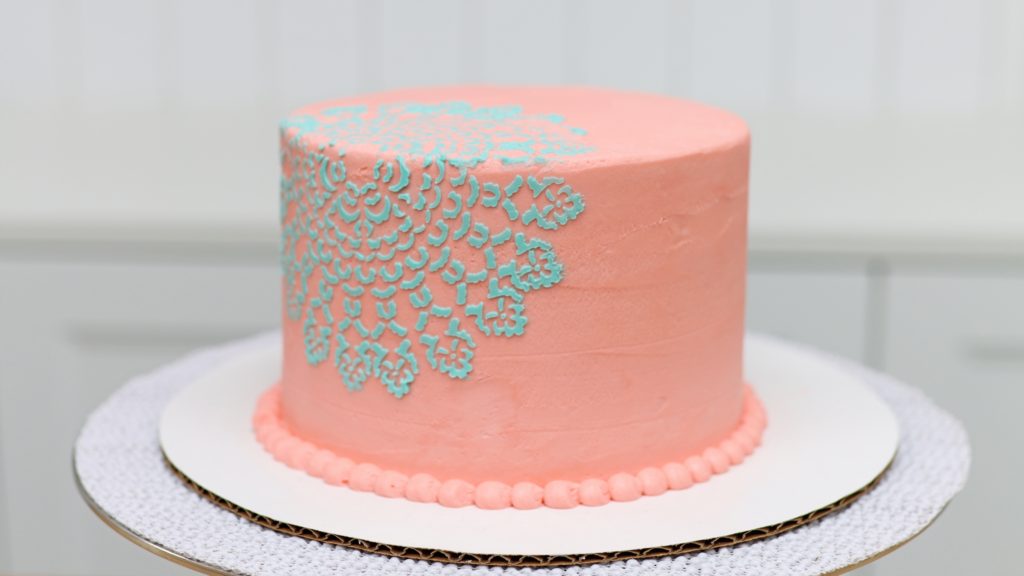
#5 Pointillism
For a step up from a flat stenciled design on a cake, use a small round piping tip like a #2 or a #3 to pipe tiny dots to cover the design, giving it texture and much more detail.
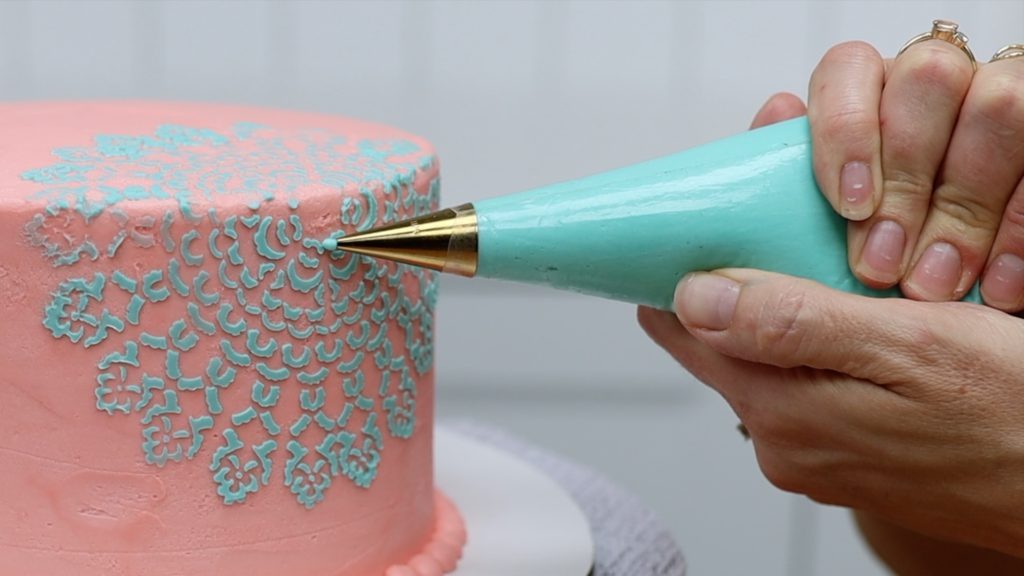
To reduce the strain on your wrist as you’re piping hundreds or dots, make sure the consistency of your buttercream isn’t too thick, otherwise you’ll need to squeeze the bag much harder than if the buttercream has a bit more milk in it to thin it out.
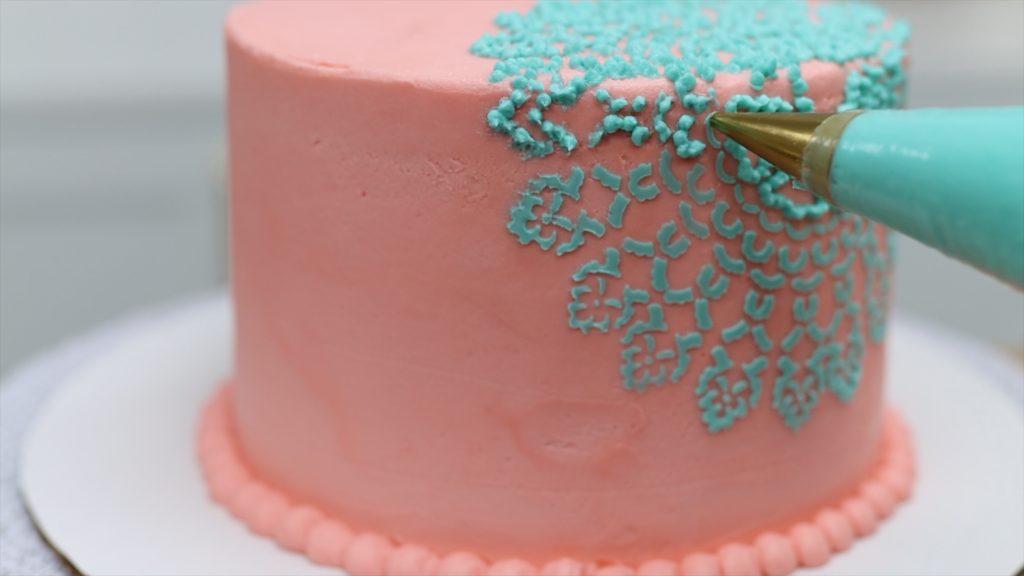
You can use whipped cream or meringue buttercream for this technique as well. It’s time consuming so take breaks but the result is definitely worth it!
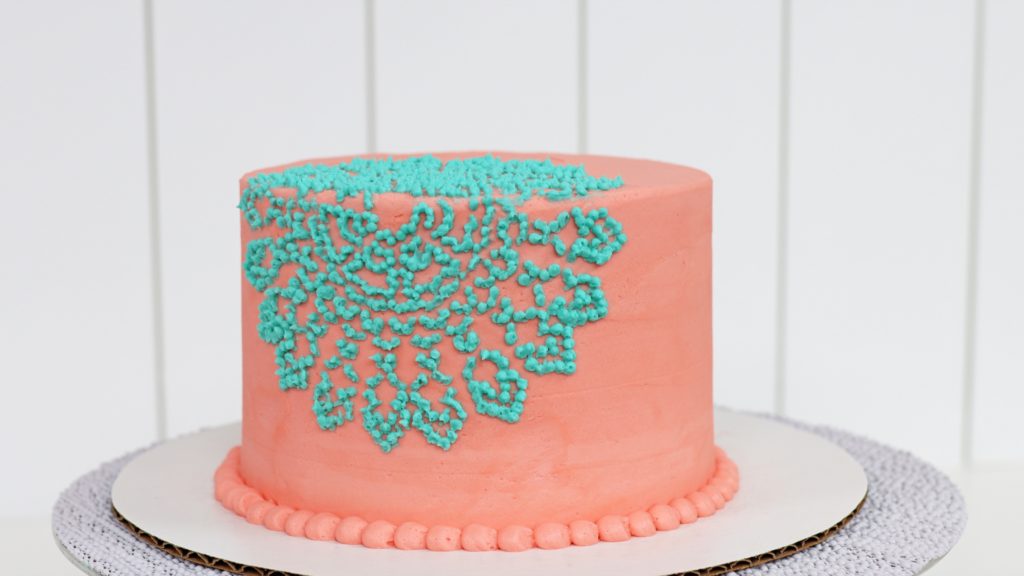
#6 Artificial flowers
Artificial flowers make gorgeous cake toppers in just a few seconds. Trim the stalks so they’re a few inches long and cut off any leaves along the stem.
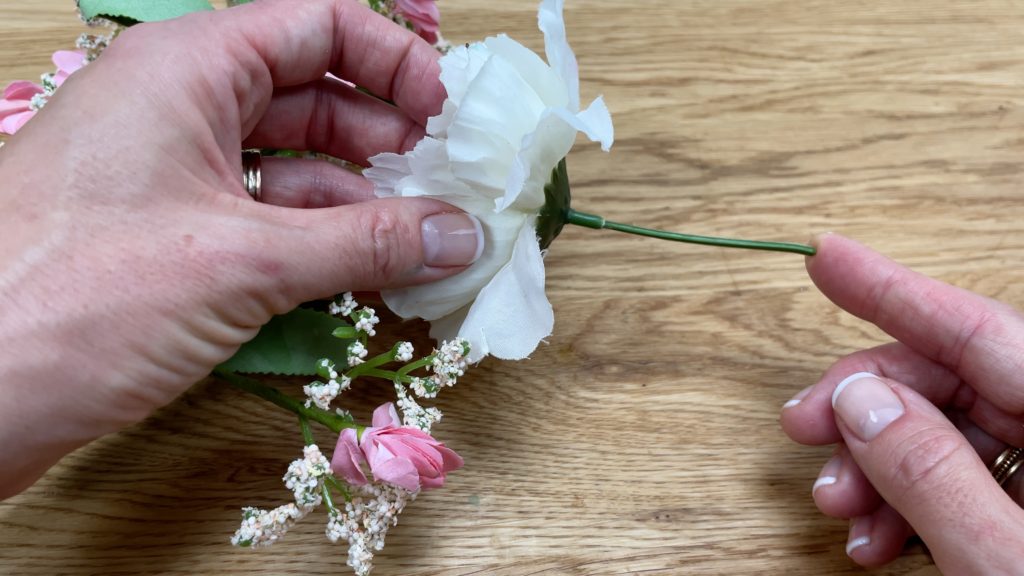
Wash the stem and the bottom petals of the flower with hot soapy water so they’re nice and clean and then poke the flower into the cake!
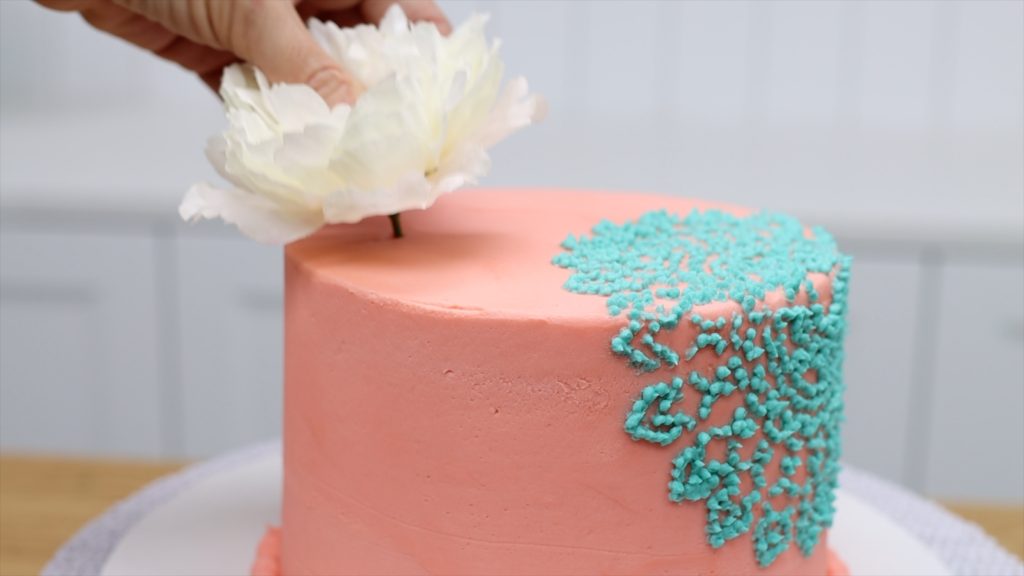
These won’t wilt like natural flowers will, and the stems won’t leak floral liquids into your cake. If you’re enjoying these techniques, check out my online cake school for hundreds of cake designs and decorating techniques!
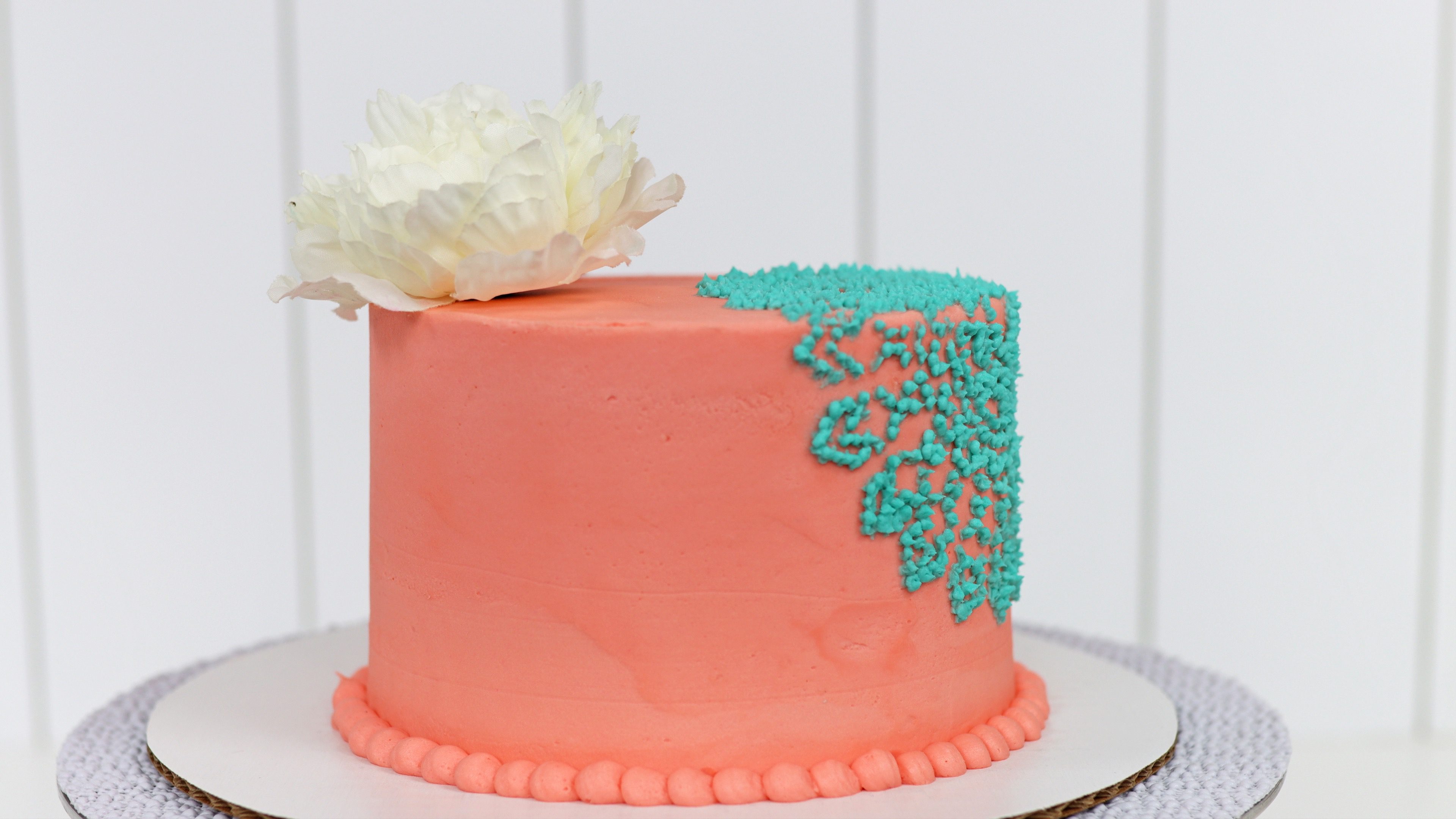
#7 Piped flowers
Add edible flowers by piping them with frosting! You’ll need a flower nail and some parchment paper cut into little squares and a few colours of frosting in piping bags.
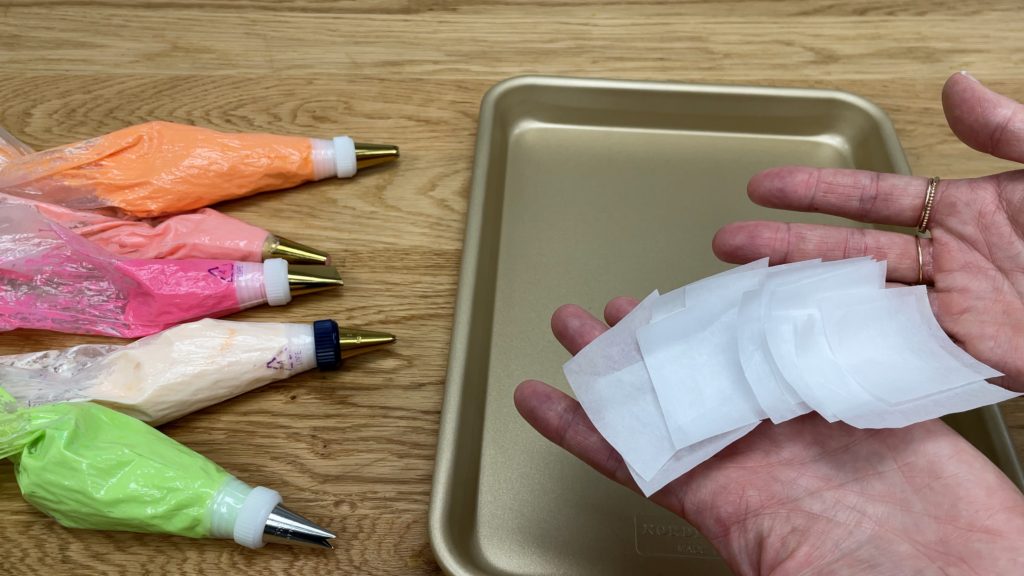
Pipe a dot of buttercream onto the middle of the flower nail. This dot will act as glue to attach a square of parchment paper onto the flower nail.
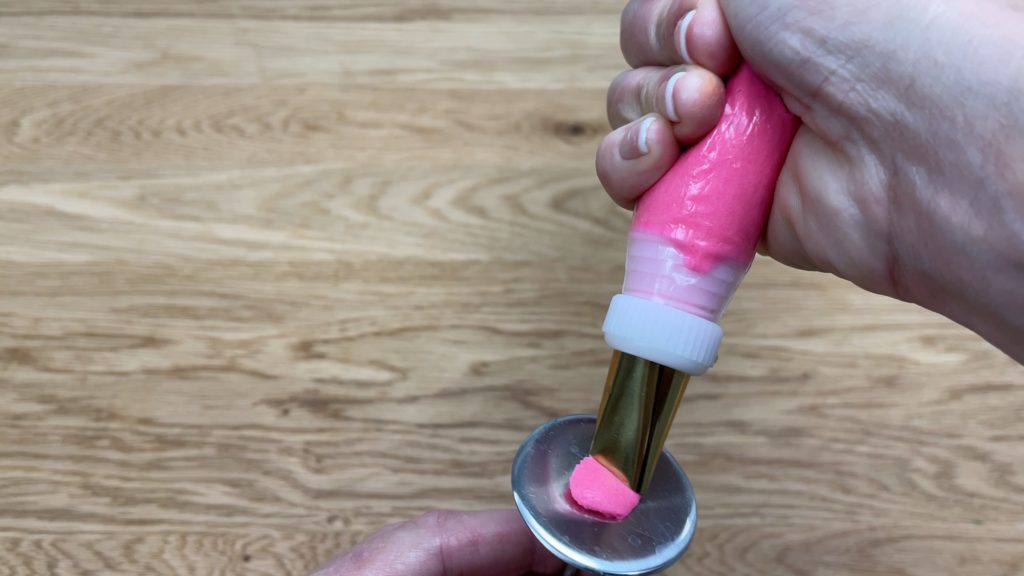
Hold a petal tip with the narrow end of the tip facing outwards. This is important because by holding it this way, the edges of your petals will have some movement and look more natural.
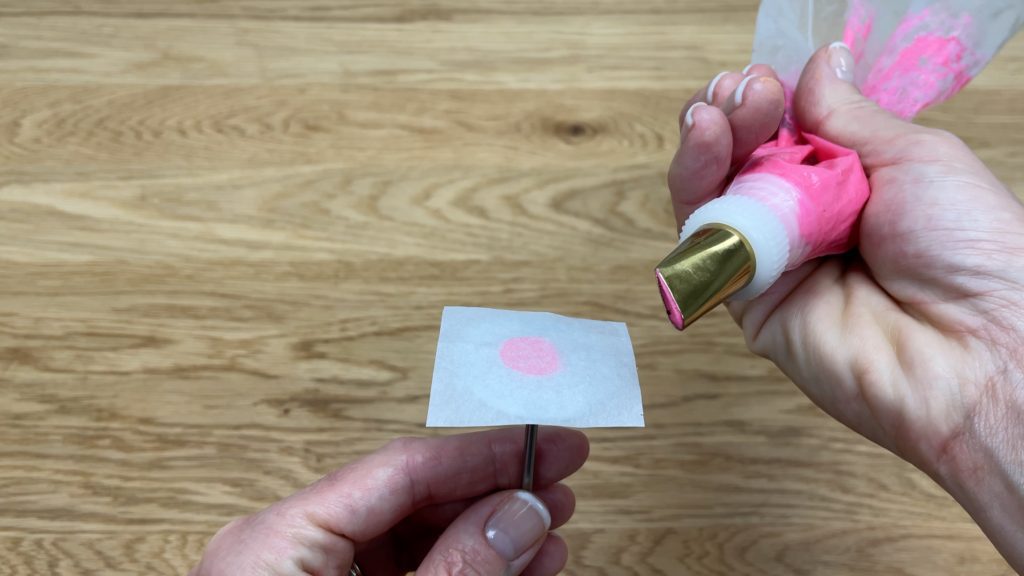
To pipe petals, spin the flower nail between your finger and thumb as you work your way around the flower.
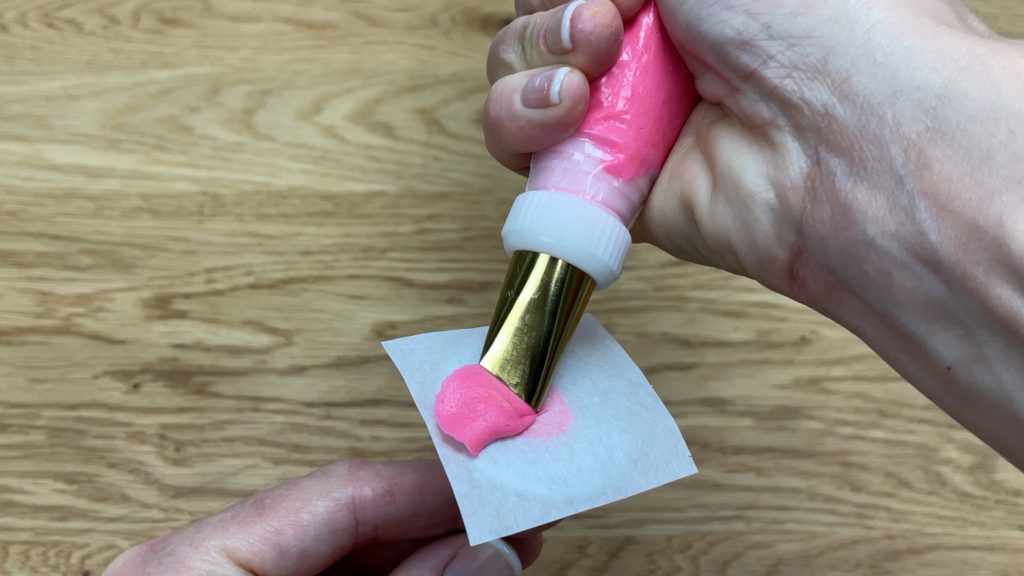
Pipe a dot in the middle or a little star – this is a #18 by Wilton.
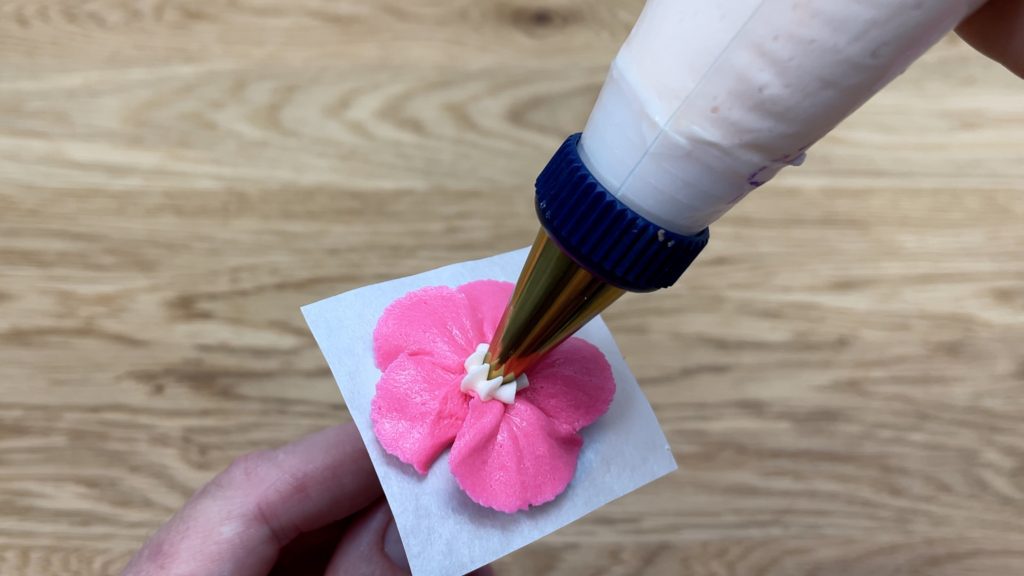
Carefully slide the parchment off the nail and place it on a tray or plate. Pipe as many flowers as you want for your cake.
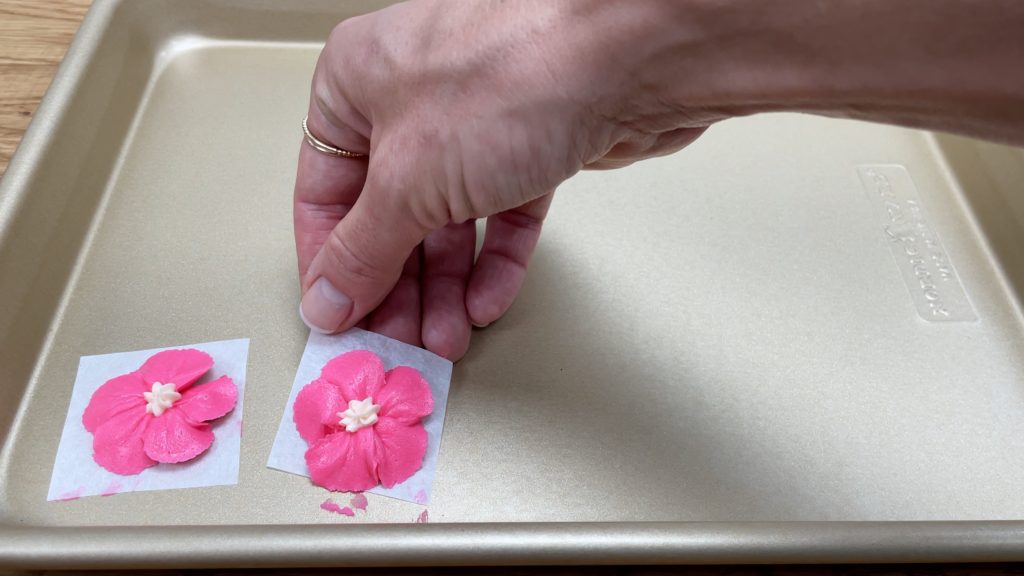
Try piping two layers of petals and use different colours to make the design more interesting. This is a #104 petal tip but for bigger flowers you could use a #125.
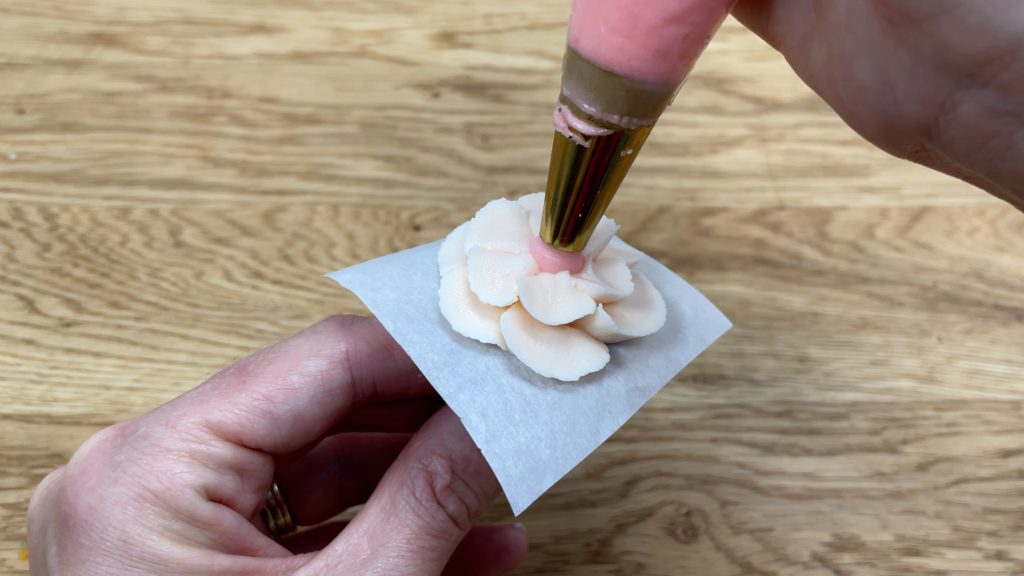
Put the tray into the freezer for 5 minutes to set the flowers. If the frosting on your cake is still soft and sticky, you can press the flowers straight into the cake but if the frosting on the cake has set, you’ll need to use buttercream as glue. Either pipe little dots or pipe leaves with a leaf tip like a #352.
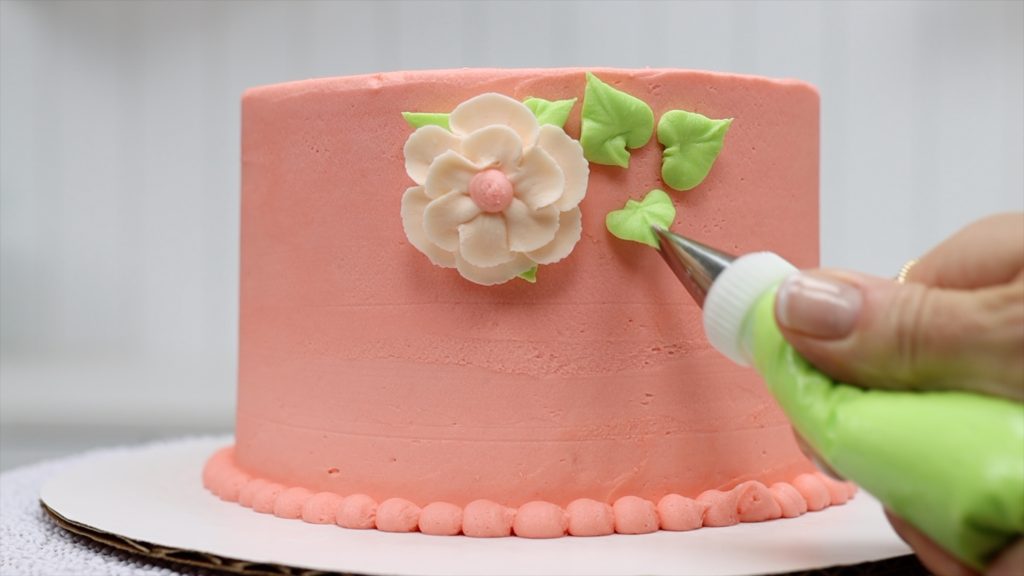
To attach the flowers, take them out of the freezer and lift a square of parchment up. Peel the flower off the parchment and it will be cold and firm for a few seconds so move quickly!
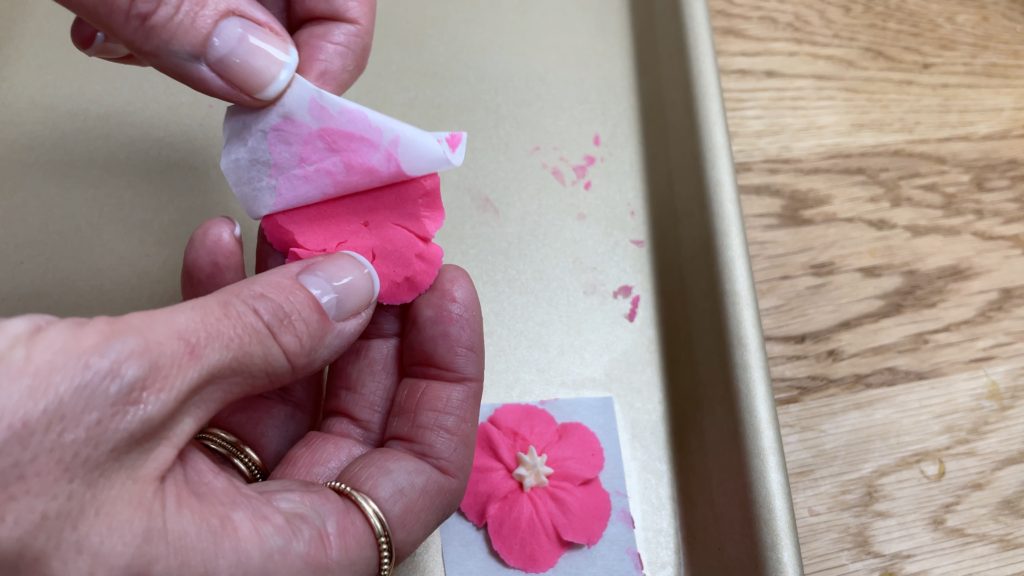
Press the flower onto your cake and it will attach to the dot or the leaves you’ve just piped.
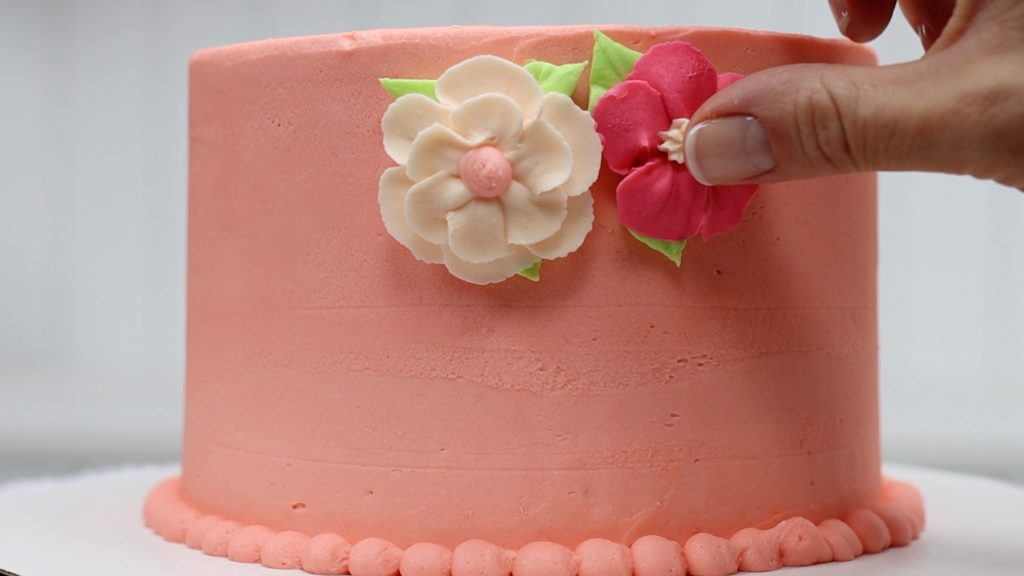
Pipe swirls and rosettes with any star shaped tip, like the #32 tip I used for the orange details on this cake. Arrange a few flowers or make them cascade down the side of the cake, making a plain cake colourful and detailed in just a few minutes!
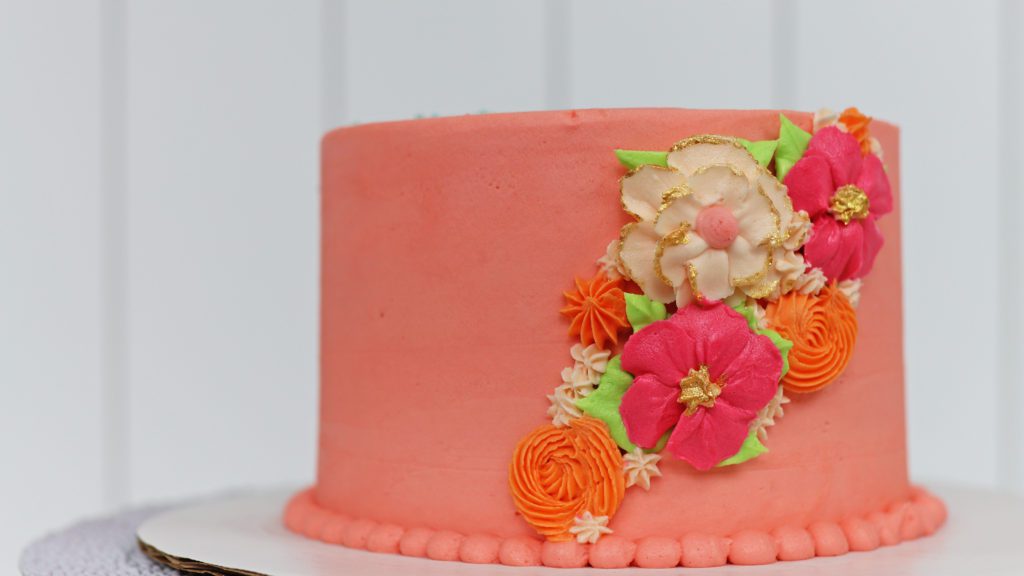
#8 Add gold
Adding gold to a cake makes it instantly glamorous and attention-grabbing because most people don’t realize gold can be edible! Buy gold luster dust and add a drop of clear alcohol like vodka or a clear flavour extract like lemon, mixing it to make a thick liquid.
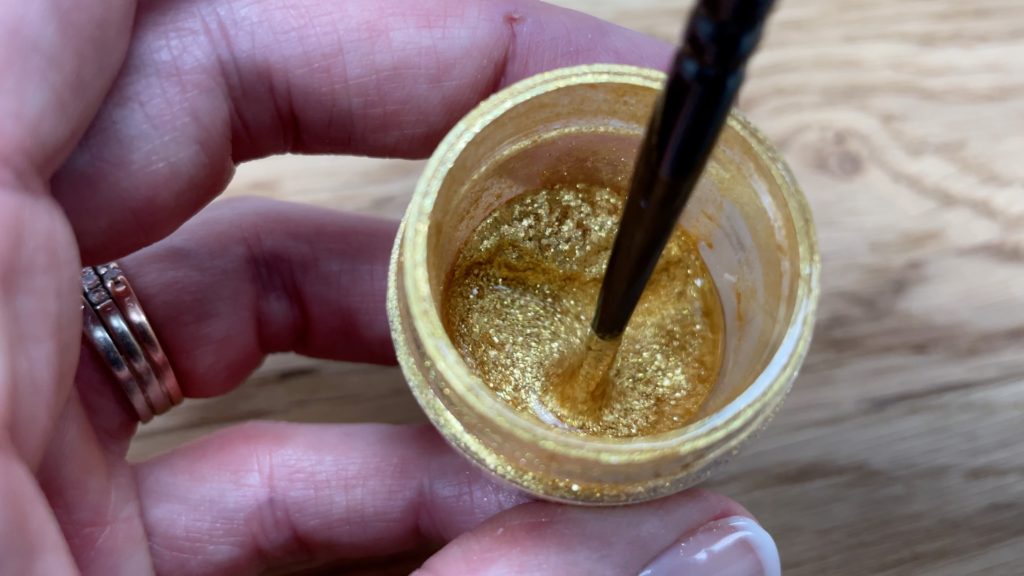
You can brush the gold “paint” over buttercream after the buttercream sets. The easiest way to make buttercream set is to put the cake int he fridge for about an hour, until the buttercream is firm enough that you can touch it without leaving an indent in the frosting.
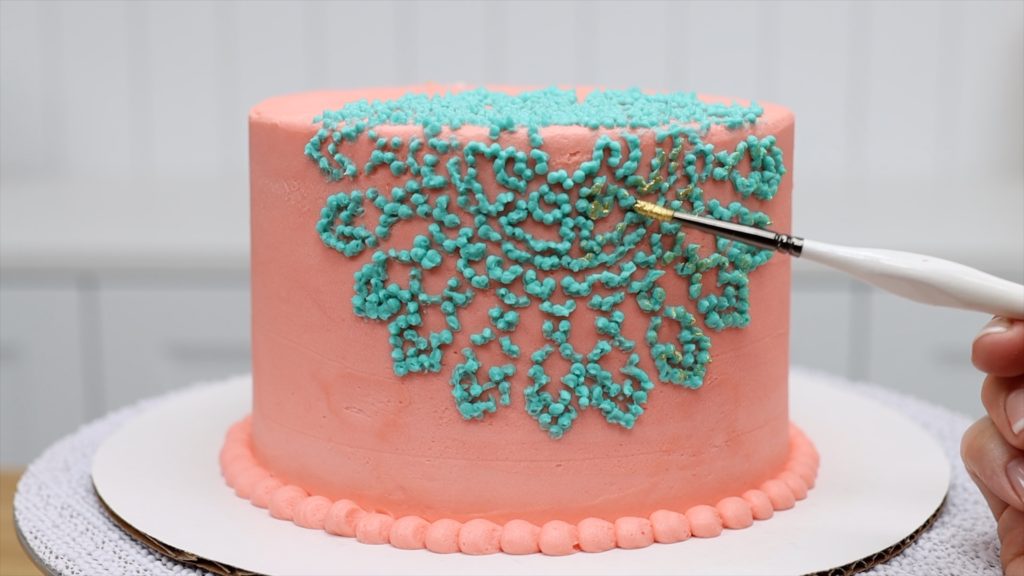
The gold accents make this design even more elegant!
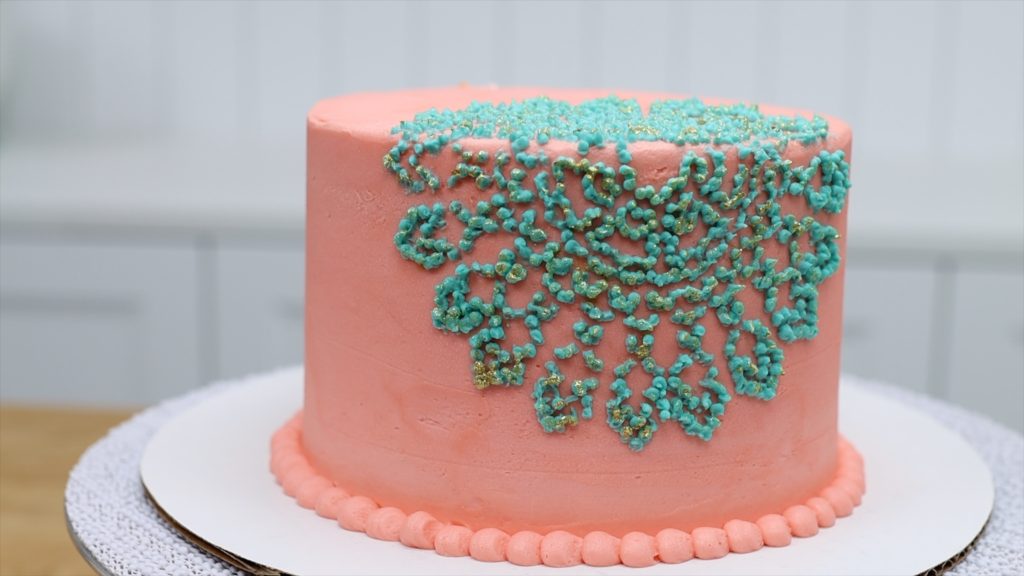
Gold paint works well for flowers too – after chilling the cake you can brush this along the edges of petals or onto the dots or stars in the middle of flowers, taking this piped design to the next level.
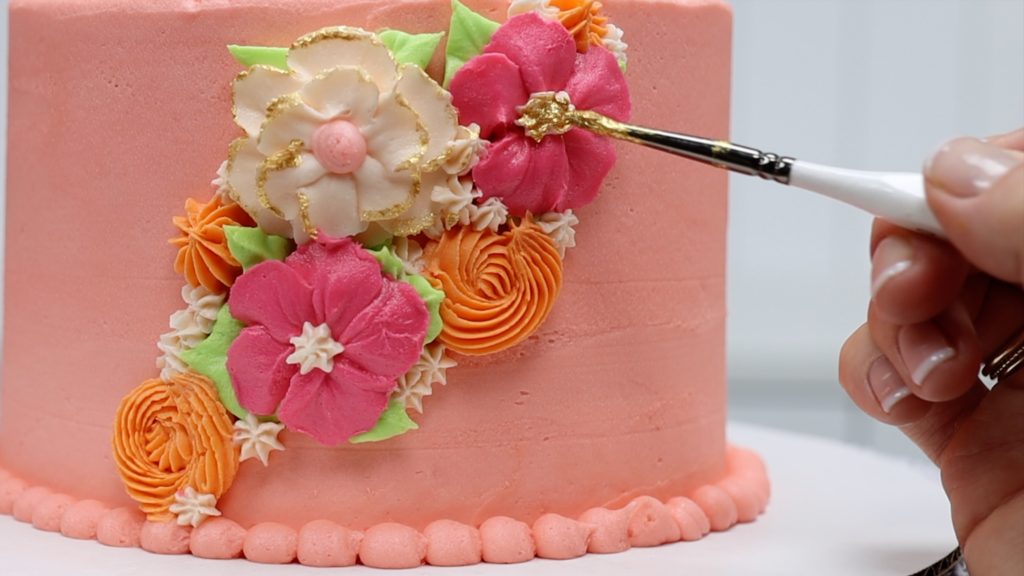
#9 Wrapped ribbon
A beautiful cake needs beautiful presentation, not a visible corrugated cake board. There’s an easy solution for this – wrap a fabric ribbon around the cake board and secure it with glue. Choose a colour that matches the colours of the cake, like this turquoise, to complete the presentation.
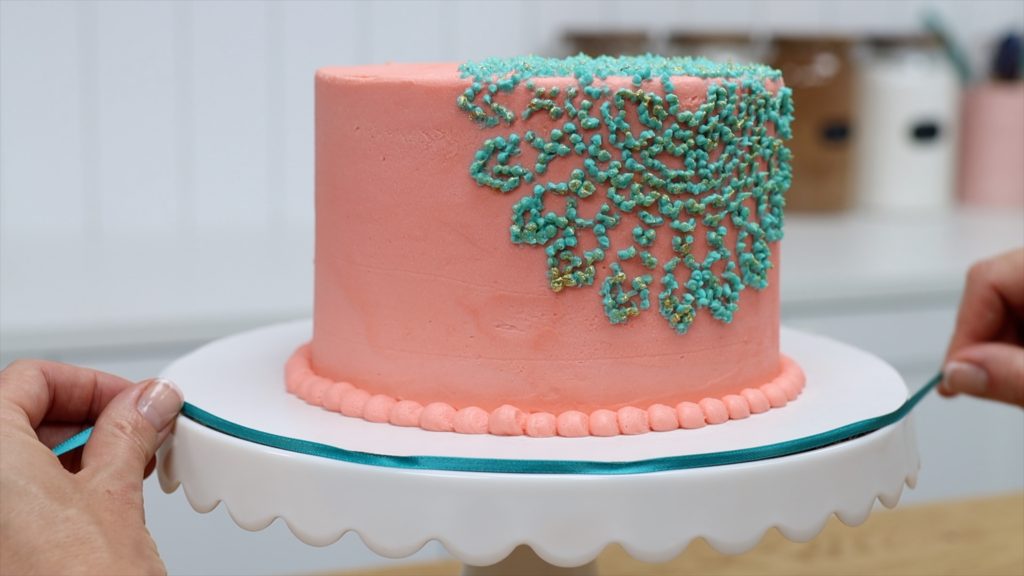
#10 Cake stand
Alternatively, transfer you cake to a cake stand, but without the cake board you frosted it on. The trick for this is to chill the cake for at least an hour so it sets, and then slide an offset spatula or a cake lifter underneath to separate it from the cake board.
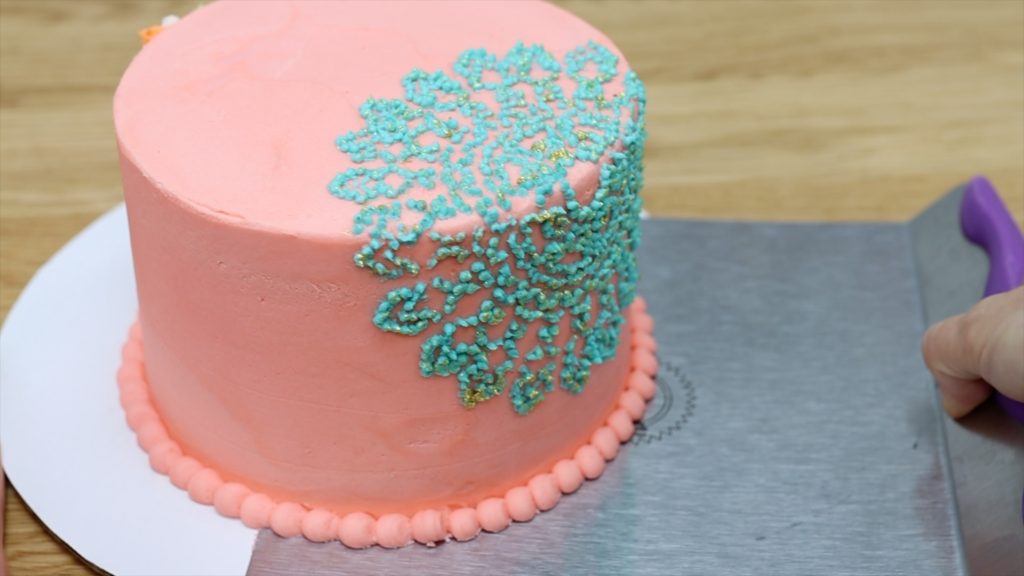
Lift the cake up and place it on a cake stand, sliding the cake lifter out from underneath the cake. You might need to use an offset spatula to lift the cake slightly while you pull the cake lifter out. If you need to center the cake not he cake stand, so it now while the frosting is still cold so you can press it without damaging it.
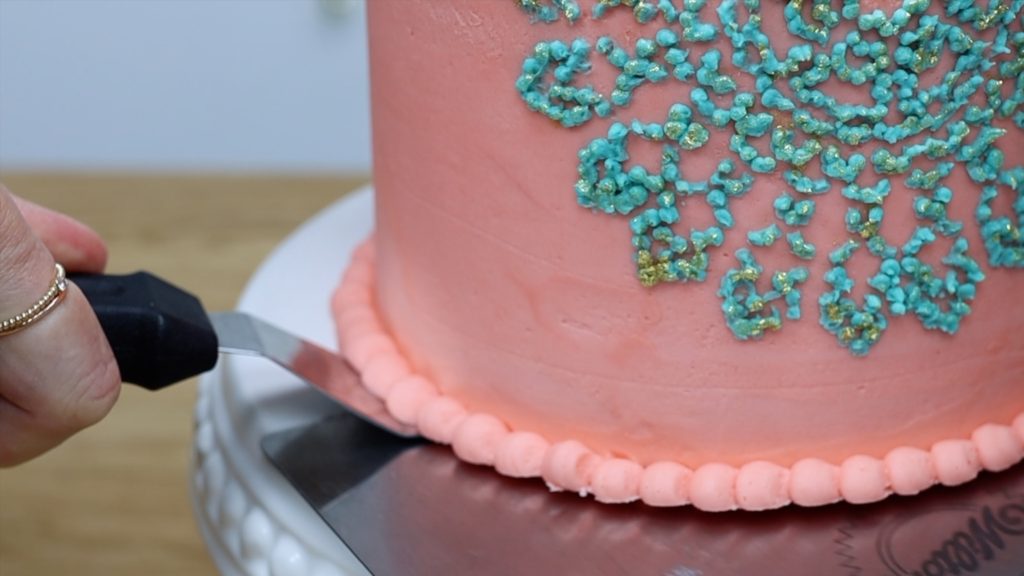
I’m excited for you to make your cakes look more professional! Tell me in the comments which is your favourite technique, or tell me one you’d like to learn!
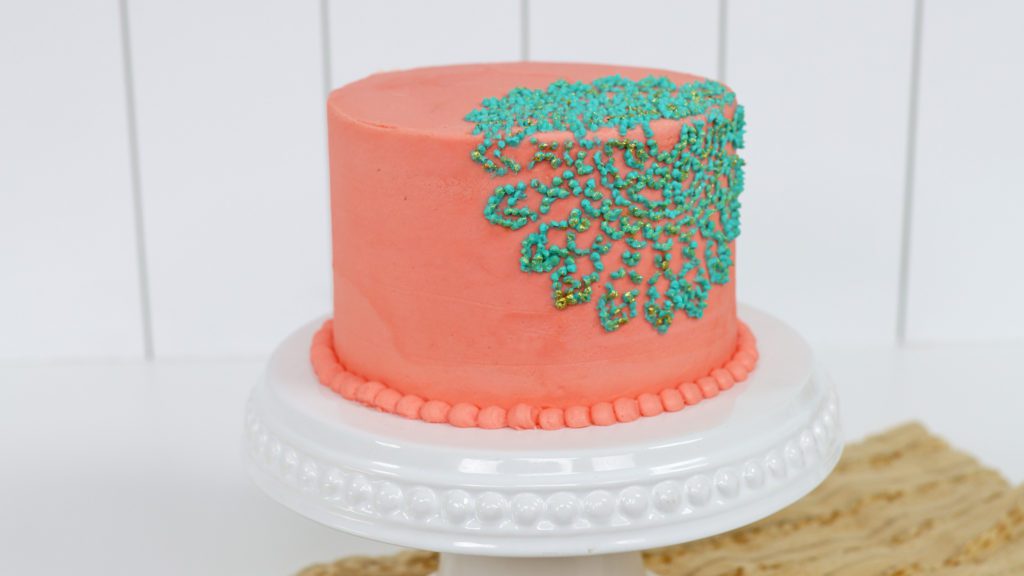
Here’s the video version of this tutorial:

Thanks Emily, I love how you explain things and don't make it all about expensive equipment. I bake lovely cakes but often am daunted when it comes to the decoration; your tutorials encourage me to have a go!
I'm so happy you find the tutorials useful! I'd love to see what you come up with!